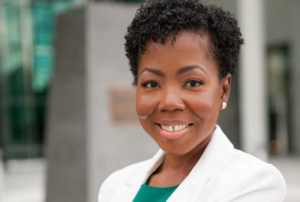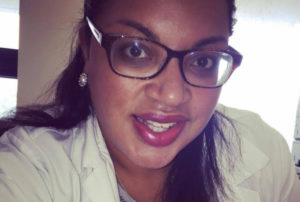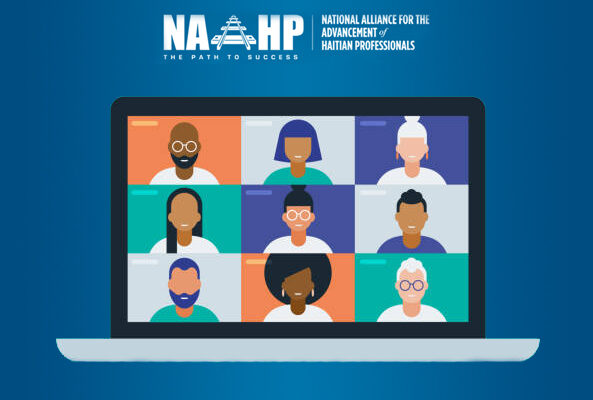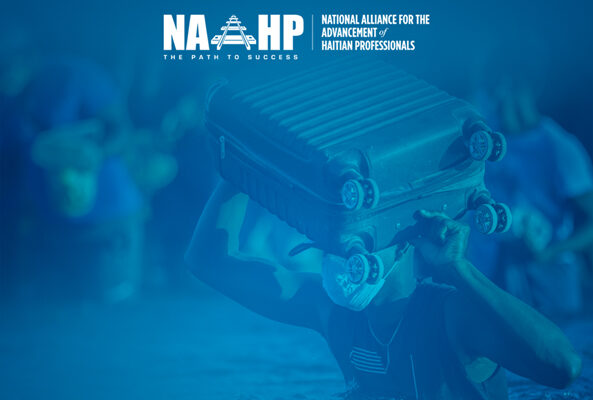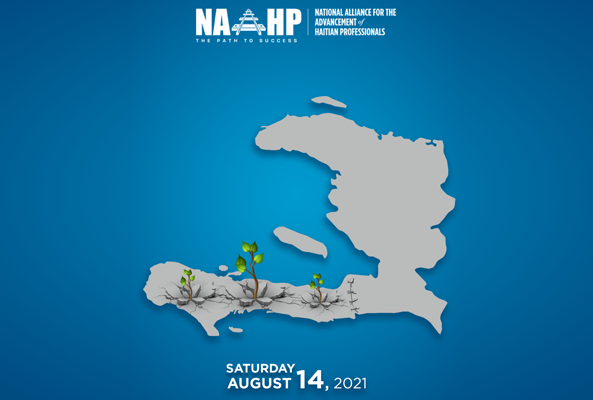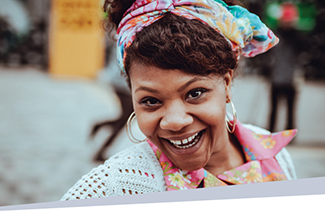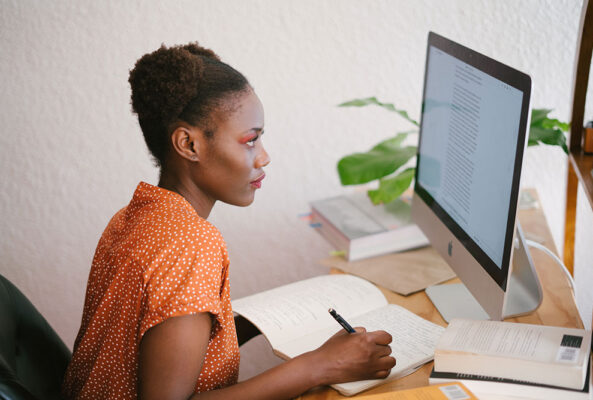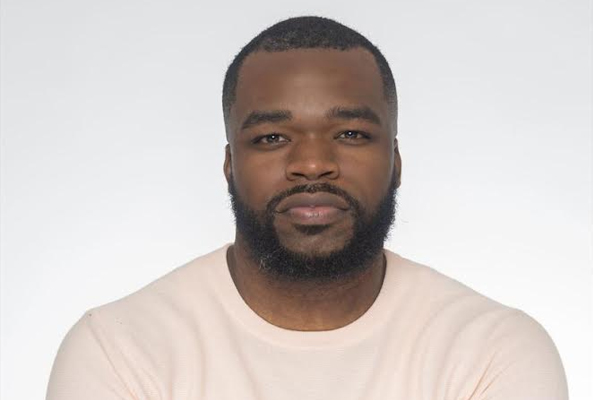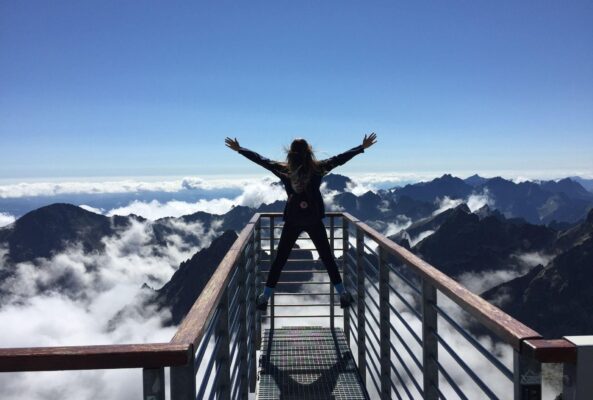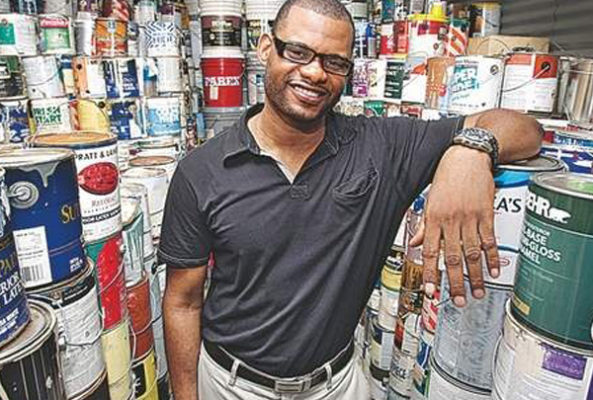
Leadership Spotlight on Rony S. Delgarde
Each week the NAAHP highlights individuals who are making a difference in their communities as well as the business world. Rony Delgarde is a native of Haiti who arrived in America at Miami International Airport over a decade ago with five dollars, a Holy Bible in his pocket and a dream to educate himself and become empowered within a career path. He is a social entrepreneur, waste management guru, an awarded founder and developer of non-profits that have impacted not only his community in the United States but third world countries that need a touch of his vision to help brighten communities and change lives while highlighting the concerns surrounding environmental preservation.
Rony founded Global Paint for Charity, a non-profit organization headquartered in Atlanta, Georgia. The organization accepts unwanted Latex Paint up to 10 years old, in most cases, could have been headed for landfills and then to our drinking water.
Learn more about Rony at linkedin.com/in/ronydelgarde.
10 Questions for Rony S. Delgarde
Dominique Elkind, NAAHP: Tell us a bit about your personal background.
Rony S. Delgarde: My background is vague and unique. I am originally from Haiti. I was very fortunate to come to the U.S. in my late 20s and went to school in Atlanta. I earned a Bachelor and Master’s degrees in Business Administration. Also, I graduated from the Gwinnett Neighborhood Leadership Institute in 2002. I received a scholarship to attend the University of Georgia’s Small Business Development Program in Nonprofit Management in 2003 and graduated from the United Way Board of Directors Involvement Program (V.I.P.) in 2010. Before starting the Global Paint for Charity, I co-founded the Volunteer Interpreter Program of Gwinnett in 2002. The program recruits bilingual volunteers to ride with the police and sheriff officers, providing on-the-scene interpretation and translation to crime victims and witnesses who don’t speak English and whose information is needed for investigations. After my graduation from college, I worked with a group of Haitian leaders in Atlanta to create the first organization called “the Haitian Community Center of Gwinnett” to help Haitian immigrants find jobs, purchase properties and become self-sufficient in the community. I left the organization two years later then move to CARE International where I worked on global issues surrounding food security and hunger, diversity, equality and sustainable economic justice, child trafficking and human rights issues.
I did my dissertation in logistics and Supply Chain Management and I was offered a job to manage the 900K sq. ft. Distribution Center at Avon Products, Inc. in Suwanee then I moved to become the Southeast Regional Distribution Center Manager at Fleetpride. Then It was time to give back, I started the Global Paint for Charity, which focuses on recycling unused paint from businesses and residents to beautify schools, orphanages, churches and family homes for needy populations in Africa, Central America, and the Caribbean.
Atlanta has given me the opportunity to create a name in the world not only in the world of waste management, beautification of underserved communities, environmental sustainability and global housing rehabilitation projects but also education and non-profits. I have served as a guest professor of social entrepreneurship, innovation eco-system and Startup at various universities. I recently presented at Florida International University, Georgia State University, Morehouse College, Clayton State University and Emory University. I have volunteered with countless organizations, through my volunteering, I recently serve on Steering Committee for Gwinnett County’s Economic Development Strategy Implementation Plan. I don’t limit my volunteering to just organizations and adults. I also am a mentor where I coach youth in the area of entrepreneurship and startups, helping them to see they are capable of achieving success with their ideas and dreams.
NAAHP: What is your vision for The Global Paint for Charity and how did you come up with the concept?
RSD: My vision for the Global Paint for Charity is to give each person in developing countries and needy communities right here in the U.S. the opportunity to enjoy the beauty of their shelter through every gallon of recycled paint. This is a big vision and we have a lot of work to do because it’s estimated that 80 percent of the third world’s family homes and schools face the dreary reality of unpainted walls, and more than 70 million children have never had access to a painted classroom.
As a child living in Haiti, the house I grew up in was not painted, and my school was not painted. According to the World Health Organization, 1.5 billion seniors are living in destitute homes and 3 million children die each year from diarrhea and bad germs on interior surfaces including unpainted walls and unsanitary conditions, also mosquito viruses result in the deaths of more than 6 million people every year.
On my very first day in the U.S., I landed at the Miami International Airport. I couldn’t believe what I saw that day. “This is a perfect adventure,” I said. I thought it’s remarkably beautiful to see a city where all houses, financial buildings, and hotels were painted with amazing colors. From that moment, I was curious about colors and wanted to help the people back at home. Later, I read an article about the EPA that estimated that every home in the U.S. has 5 to 10 gallons of unused paint in their basement and approximately 10 percent of the 1.5 billion gallons of paint sold in the U.S. each year becomes leftover paint and no one was doing anything about recycling that paint. I was shocked just to know how many gallons of paint were thrown away every year. I immediately launched The Global Paint for Charity to solve these two issues. One is the waste issue and the other is the issue of sanitation solution that advances sustainability through business solutions.
But I was first inspired to collect paint in March 2010, when I took a trip to Kenya and Uganda to help donate basic health supplies and nutrition kits to mothers in the refugee camps. That’s where I realized the need to beautify global housing projects in the region. Most refugees were hungry and had no opportunity to find work or to earn money to buy food, medicine or paint for their temporary tents which were the most common form of shelter in the refugee camp. It was very sad to see the living condition of humankind. And I immediately started collecting paint after that Africa trip.
When I started I picked up all paint donations myself; I have gone to residences and businesses as far away from Atlanta as Macon and Savannah, Georgia to collect paint. As many as 5000 to 6000 gallons paint have been shipped at a time to 24 countries in West Africa, Central America, the Caribbean, and war-torn areas of the Middle East and beyond — even places like New York, Chicago, Westside Community Atlanta, New Orleans, and Broward Community in Florida suffering from floods, storms, earthquakes and other natural disasters — have received great number of gallons of paint donations from Global Paint for Charity. We also work with local youths, community groups and volunteers on the ground from organizing paint drives to applying a splash of color to the lives of the underprivileged and senior elderly residents in our communities. To date, over 200,000 gallons of paint has been distributed to the needy populations in targeted communities all around the world. Most of the paints are from major top brands including AkzoNobel, PPG, Ralph Lauren, Dunn Edward, Benjamin Moore, Sherwin Williams, ACE Hardware, Valspar to site a few. The distributed paint has a market value of $6.5 million which made it one of the largest donations of Foreign Aid to the developing countries without the assistance and support from the U.S. Government.
Global Paint believes it is our mission to keep these hazardous materials out of landfills and make this valuable resource available in areas where paint is scarce. Our paint does not only make communities brighter and more beautiful, but it also protects against mold, bad bacteria, and dangerous germs. The presence of which have a significant the health of less fortunate communities. And of course, our efforts better protect the environment by recycling paint, instead of dumping it in landfills.
Over the past 7 years, I have devoted my life to donating paint to communities in need, both in the U.S. and abroad. I recently opened a plant in Honduras to provide paint to their projects in Central America, and will soon build similar facilities in Cameroon, Ghana, and Haiti. With the donated paint, Global Paint will continue to help families in need, encouragingly transforming their communities while protecting our planet one gallon of paint at a time.
NAAHP: How does The Global Paint for Charity support the Haitian economy?
RSD: Great question! I think that the idea of colors or simply the paint industry is one of the most impactful industries in the world in the past 800 years, and will continue to impact the local economy. Paintings provide two primary functions decoration and protection that are of considerably impactful to the advancement of the economy of a nation. About 52% of the paint produced worldwide is used to decorate and protect new construction as well as to maintain existing structures, including residential properties, family homes, apartments and public and financial buildings, and large distribution center or factories. Another 38% of the paints are used for commercialization to differentiate and/or protect industrial products (called finished goods or branding and packaging). Therefore we all can agree that paints facilitate the economy in many ways. For example, in places where the buildings and residential properties are painted the economy is better and so growth continues in every aspect of the society.
Haiti’s economic landscape can benefit from the paint in both with long-term and short-term while having a major impact in lack of sanitation care. Haiti used to be noticed around the world because of the Haitian art with its complex tradition, reflecting African roots using very bright colors on beautiful pieces of arts. Whether for cultural or aesthetic and religious presentations, the Haitian history has been represented by beautiful arts however 80% of the residential properties and schools are in immediate need of TLC. Yes, people need clothes, food, shoes etc, however, we need to focus on the physical image of the Haitian communities. I think that the work we have done with the Global Paint for Charity has a lot to do with the economy. At Global Paint, we use colors to beautify underprivileged communities around the world. We focus on empowering and supporting the positive development of needy populations in a way that engages their natural innovation and creativity to create beautiful and sustainable communities.
Global Paint for Charity is fully involved in many regions in Haiti. In 2013, as part of the preparations to reopen “La Citadelle Laferrière,” I traveled to the motherland to paint a wall, and I spoke at the official open ceremony and celebration on November 17, 2013. The Citadelle is one of the most popular tourist destinations in Haiti, attracting crowds of visitors from Europe, Asia, South America and North America each year and hired hundreds of local workers for years to come. Check this link for more detail and photos of me at the Citadelle. Moreover, Global Paint donated paint to support many rehabilitation projects in different regions in Haiti. We have also sent paint to those affected by the 2010 earthquake that killed over 200,000 people and left a million others homeless in Haiti. And we nominated Nadege Telfort, one of the leading actresses based in Haiti, as Global Paint for Charity’s Goodwill Ambassador we made a commitment to donate 20k gallons of paint to Haiti. She is taking on the mission to provide high quality of paint to renovate schools, orphanages, hospitals and family homes in Haiti. Currently, she is working with the Mayor of Port-Au-Prince to paint 13 basic schools, 7 churches and some family homes in Camp-Perrin, Haiti. In fact, one of my future goals is to build a paint manufacture in Haiti to contribute to the beautification in the entire Island. Any investors or donors interested can contact us or visit globalpaints.org.
NAAHP: How did your background and expertise in business management prepare you for your current role?
RSD: My experience from both volunteering and working in the private sector have definitely added value to my current position as founder and CEO of the organization. I have volunteered at major large nonprofit organizations for the past 10 years in a variety of volunteer-related roles. I have traveled in many developing countries around the world and seen the need for color in needy communities. Also, my education provides me with the skills necessary to be a productive team member on the board of GPC. I’ve earned my green belt in Six Sigma, where I have used that knowledge to analyze processes, correct inefficiencies, eliminate waste to save my organization in both shipping costs and operation.
One of the key elements in my current role is the ability to manage my time daily, weekly, monthly and annually, and the ability to create meaningful and positive working relationships with a wide variety of people. Also my ability to speak and understand other languages such as French, Spanish, English and Haitian Creole.
For me, I’ve been at this for over 7 years, I founded the organization from my patio and I’m super proud of everything we have accomplished and I’m looking forward to greater achievements. There is always room for improvements. In the first half of our existence of the organization, I carry many hats, I spent a lot of time doing everything from collecting the donated paint, drive commercial trucks to writing strategies and social media contents but now I have a great team, as well as volunteers, and corporations doing a lot of daily business works. In the past few years, I have learned a lot more about myself. And I think that’s something that’s prepared me to this role now.
Lastly, a founder or CEO can’t do it all the work or know it all. To execute my vision, I need a great team of wonderful people. I have been grateful to recruit a passionate team with diverse backgrounds and expertise dedicated to serving the mission of Global Paint for Charity and providing governance and guidance to the organization. Everyone focuses on achieving great results. I keep telling my audiences that if you do what you love, you would haven’t worked a single day. A successful company has a successful team of great leaders, who can drive productivity, profound relationship, ruthless execution and positive results through a common culture, of trust and respect within each other. And the team worked tremendously hard to achieve great results. I feel like we will really take the organization to the next level.
NAAHP: What is the biggest challenge of your work?
RSD: As the CEO of such a humble cause, I have new challenges almost daily. I can be working on approving a large donation of a 40ft container of paint to a country in Africa or Central America one day, to reviewing a complete proposal to implement another GPC program or implementing a new strategy for our projects on another day, to trying to review reports from other projects the next or going to 6 or 7 meetings including webinars and conference calls each day.
I also serve on the audit committee, fundraising committee of GPC Board. In these roles, I help facilitate efforts in all aspects of the organization operations from managing the inventory to speaking engagement and doing presentations etc. In order to achieve those activities I have to keep improving, building new skills and trying to ensure that the organization is performing at its highest standards. We have a lot of donated paint from many states and major cities in the U.S. and many people sending a request for paint donation, it is hard to keep up with it all every day. Paying attention to these unique and daily activities definitely, helps us run a smooth and efficient operation at a time.
NAAHP: What’s the most important leadership lesson you’ve learned?
RSD: The most important leadership lesson I have learned is realizing that life is an endless process. When you get out of college you say: “I have gotten my degree, I graduated with a great G.P.A., now I’m going to find that BIG job in a well-distinguished company, get married etc.” No, that is not always the reality. Instead, you have so much to learn. Part of what you’re going to learn about is the person you really are, you must learn about your interpersonal skills, your attitude, are you trustworthy enough? can you lead others? can you communicate your ideas clearly? To become a leader it is your responsibility to keep learning, become a better listener, and always do your best to deliver outstanding results.
I had many students or new entrepreneurs at my top speaking engagements say, “ I will find a job after college and I won’t stay in it year after year. I will develop an app and I will sell it to Google or Apple then buy my own island in the Caribbean” I said, “Well, you will be very disappointed if you can’t find that job next year.” I’ve had taken many jobs while building my organizations, but I haven’t had the same job title. The most important leadership lesson is that “You have to evolve.”
NAAHP: What advice can you give to entrepreneurs?
RSD: Always make sure what you are providing is something that is going to help the people in need or making their life easier. If you plan to start your own organization, you need to be absolutely committed to and happy with what you are doing. If you’re not happy to take on the daily challenges that come with starting your own organization, your startup or whatever business idea it is you will not do a good job of impacting others. If you’re looking to make a high impact in the social change arena and have a new idea, enterprising plan on how to do it, starting your own programs could be a great choice for success. But you have to do the work. Start where you are and keep moving forward. Don’t think you should wait until you have the most valuable resources or the best solution to a particular problem.
If I would have had to wait until I get rid of my beautiful English accent, or find enough rich friends to support my idea before I launched it, Global Paint for Charity would have never created. Nobody knew that Haitian young man would come to the U.S. with no knowledge of English, and create a 6 million dollars idea impacting communities in 24 countries in Africa, Latin America and the Caribbean. We are providing the paint to people all over the world, and their house, classrooms, and communities are painted for the first time. So, believe in yourself and never give up!
NAAHP: How do you prioritize your time?
RSD: As an entrepreneur your daily activities are going to fill a large percent of your time, and the only way to be truly successful is to do what you believe is making you happy. And the only way to do what is making you happy is to love what you do. If you haven’t found that out yet, keep studying yourself. And, like any great relationship, it just gets better and better as the years change. I have lots of activities, but I love what I do every day. In my case, I delegated the tasks such as calendar management, travel planning, scheduling meetings and booking speaking engagements to my Executive Assistant. And I will do what she says. She knows my expectation… Regardless, it is the easy way to keep track of these daily activities.
A personal note: Be ready to change! A very important example comes from my young adulthood. As a young Haitian, I had always struggled with being on time. I would be late for most of my important meetings including board meetings and I feel okay. But it was not okay to my other board members. And one day, I decided I wanted to change that and never late again once and for all. And I started to manage my time every day, and I started to arrive at any meetings 30 minutes before the starting time, I have been on time for the past 3 years even in bad traffic congestions I have still managed to be on time. I felt like this has been the most rewarding experience.
NAAHP: What are your personal or professional journey highlights thus far?
RSD: Well, the Global Paint organization and I have received so many distinguished awards including, but definitely not limited to the Energy Globe Award winner 2017, The ENERGY GLOBE Award is one of today’s most prestigious environmental awards in the world. Just last Wednesday, I received the Metro Atlanta Chamber E3 Awards 2017 for NEW VENTURE category for startup or new business that advances sustainability through business solutions. I obtained The Empire Board 58th President’s Awards, also awarded as the Outstanding Georgia Citizen and Goodwill Ambassador from the Secretary of State of Georgia, awarded the 2015 Best of Atlanta Company for leading a best Waste Recycling Service in Atlanta Georgia, and awarded the Allstate Insurance Company’s Champion for Good of the Year in 2013. Those awards allow me to remember I am not here to be just here. I have the power to make a difference every day.
I am very blessed to be able to beat the odds. However, I have experienced more than anyone could imagine. Overcoming obstacles in my life has helped me to contribute to who I am as an individual, an immigrant, and a dreamer. I have made better decisions, embraced new challenges in my path, and contribute positive methods to ensure positive thoughts and success in my life. The past 14 years of my life I have struggled a lot in the state. But, when I was offered an opportunity, even as a volunteer, I also saw another opportunity; the opportunity of turning waste into hope, happiness and change lives. The biggest highlight in my life is that I have associated with people that can inspire me, people that have challenged me to rise higher, people that teach me better things in life. I don’t waste my valuable time with people that are not adding to my growth. My time is very crucial.
I started this organization in my one bedroom apartment; now we’re in Chicago, in California, Boston and known by a lot of people in the development communities around the world. There’s nothing as powerful as a small idea that has the ability to change the lives of people around the world.
NAAHP: When you’re not at work, where can we find you?
CSN: I have too many hobbies. I enjoy helping in our community and being active. I have been a volunteer at local hospitals for nearly 15 years, I enjoy working to help injured and sick patients get back to their routines. I like the discipline in traditional martial arts, soccer, fashion and keeping in shape. Of course, I love to read, write social media content and travel. I also love politics; The insights from CNN’s Fareed Zakaria GPS, Sundays 10 a.m. & 1 p.m. ET help me make sense of the real world, also I listen to NPR. I love youtube and listen to other incredible individuals impacting our world in positive ways. I love to go to church and love to shop, you can find me at Phipps Plaza in Buckhead or at a thrift store in Charleston or in Chicago looking for new items. It is all about finding the unique articles or a typically colorful piece is my little weapon secrets for my style. I love to dance and I like French food and beverages you may run to me or catch me with few key friends at the Bilboquet, American Cut, Dolce Italian, Shake Shack, Gypsy Kitchen or Eclipse di Luna in Buckhead.

 English
English Français
Français Donate
Donate Partner
Partner Shop
Shop Login
Login